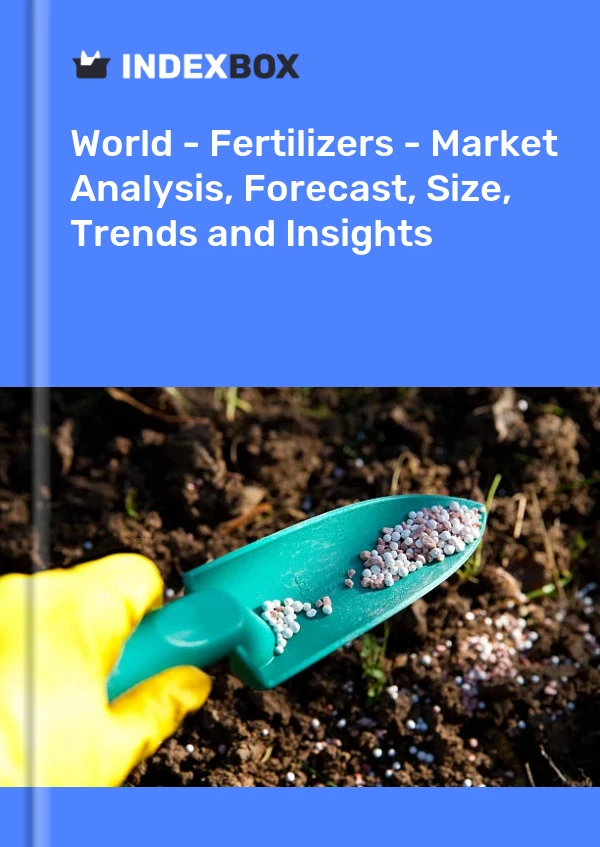
World - Fertilizers - Market Analysis, Forecast, Size, Trends and Insights
Get instant access to more than 2 million reports, dashboards, and datasets on the IndexBox Platform.
View PricingChemical Fertilizers and Pesticides Used in Agriculture
Chemical fertilizers and pesticides are widely used in agriculture to enhance crop growth, increase productivity, and protect plants from pests and diseases. However, their use also raises concerns about the environment and human health.
Chemical fertilizers:
Chemical fertilizers are synthetic substances that provide essential nutrients to plants. They are commonly categorized into three types: nitrogen-based, phosphorus-based, and potassium-based fertilizers.
Nitrogen-based fertilizers: These types of fertilizers contain various forms of nitrogen, such as ammonium nitrate, urea, and ammonium sulfate. Nitrogen is an essential nutrient for plant growth, and these fertilizers help promote leaf and stem development.
Phosphorus-based fertilizers: Phosphorus is necessary for plant root development, flowering, and fruiting. Chemical fertilizers like superphosphate and triple superphosphate provide plants with readily available phosphorus.
Potassium-based fertilizers: Fertilizers containing potassium enhance overall plant health, water absorption, and resistance to diseases. Potassium sulfate and potassium chloride are commonly used potassium-based fertilizers.
While chemical fertilizers can greatly enhance plant growth and crop yield, their overuse can lead to several negative impacts. Excessive application of nitrogen-based fertilizers can result in nutrient runoff, leading to water pollution and eutrophication of water bodies. This can disrupt aquatic ecosystems and harm fish and other aquatic organisms.
Phosphorus runoff from agricultural fields can also contribute to water pollution, as it promotes algal blooms and depletes oxygen levels in water bodies, creating dead zones. Additionally, excessive use of chemical fertilizers can degrade soil quality, leading to reduced fertility and increased dependence on fertilizers to maintain productivity.
Chemical pesticides:
Chemical pesticides are substances formulated to control or eliminate pests, including insects, weeds, fungi, and bacteria. They are used to protect crops from damage and prevent yield losses.
Insecticides: These pesticides are specifically designed to control insects and can be broad-spectrum or narrow-spectrum. Broad-spectrum insecticides are effective against a wide range of insects, but they can also harm beneficial insects and pollinators. Narrow-spectrum insecticides target specific types of insects, reducing their impact on non-target species.
Herbicides: Herbicides are used to kill or control unwanted plants, commonly known as weeds. They help ensure that crops have adequate access to nutrients, water, and sunlight by reducing competition from weeds.
Fungicides: Fungicides are used to control fungal diseases in plants. They help prevent the spread of diseases that can damage crops and affect their overall productivity.
Bactericides: Bactericides target bacterial pathogens that can cause diseases in plants. Their use helps protect crops from bacterial infections and maintain plant health.
However, the use of chemical pesticides also has potential drawbacks. They can accumulate in the environment and pose risks to non-target organisms, including humans. Pesticide residues on food crops can lead to human exposure and potential health effects. In addition, excessive use of pesticides can lead to the development of pesticide resistance in target pests, making them more difficult to control.
Overall, while chemical fertilizers and pesticides have played a significant role in modern agriculture, their use should be properly regulated and balanced with sustainable farming practices to minimize their negative impacts on the environment and human health.
This report provides an in-depth analysis of the global fertilizer market. Within it, you will discover the latest data on market trends and opportunities by country, consumption, production and price developments, as well as the global trade (imports and exports). The forecast exhibits the market prospects through 2030.
Product coverage:
- FCL 4025 - Potassium nitrate
- FCL 4004 - Calcium ammonium nitrate (CAN) and other mixtures with calcium carbonate
- FCL 4005 - Sodium nitrate
- FCL 4023 - Monoammonium phosphate (MAP)
- FCL 4001 - Urea
- FCL 4002 - Ammonium sulphate
- FCL 4003 - Ammonium nitrate (AN)
- FCL 4006 - Urea and ammonium nitrate solutions (UAN)
- FCL 4016 - Potassium chloride (muriate of potash) (MOP)
- FCL 4021 - NPK fertilizers
- FCL 4014 - Other phosphatic fertilizers, n.e.c.
- FCL 4022 - Diammonium phosphate (DAP)
- FCL 4027 - PK compounds
- FCL 4024 - Other NP compounds
- FCL 4008 - Other nitrogenous fertilizers, n.e.c.
- FCL 4012 - Superphosphates above 35%
- FCL 4013 - Superphosphates, other
- FCL 4018 - Other potassic fertilizers, n.e.c.
Country coverage:
Worldwide - the report contains statistical data for 200 countries and includes detailed profiles of the 50 largest consuming countries:
- USA
- China
- Japan
- Germany
- United Kingdom
- France
- Brazil
- Italy
- Russian Federation
- India
- Canada
- Australia
- Republic of Korea
- Spain
- Mexico
- Indonesia
- Netherlands
- Turkey
- Saudi Arabia
- Switzerland
- Sweden
- Nigeria
- Poland
- Belgium
- Argentina
- Norway
- Austria
- Thailand
- United Arab Emirates
- Colombia
- Denmark
- South Africa
- Malaysia
- Israel
- Singapore
- Egypt
- Philippines
- Finland
- Chile
- Ireland
- Pakistan
- Greece
- Portugal
- Kazakhstan
- Algeria
- Czech Republic
- Qatar
- Peru
- Romania
- Vietnam
+ the largest producing countries
Data coverage:
- Global market volume and value
- Per Capita consumption
- Forecast of the market dynamics in the medium term
- Global production, split by region and country
- Global trade (exports and imports)
- Export and import prices
- Market trends, drivers and restraints
- Key market players and their profiles
Company coverage:
Reasons to buy this report:
- Take advantage of the latest data
- Find deeper insights into current market developments
- Discover vital success factors affecting the market
This report is designed for manufacturers, distributors, importers, and wholesalers, as well as for investors, consultants and advisors.
In this report, you can find information that helps you to make informed decisions on the following issues:
- How to diversify your business and benefit from new market opportunities
- How to load your idle production capacity
- How to boost your sales on overseas markets
- How to increase your profit margins
- How to make your supply chain more sustainable
- How to reduce your production and supply chain costs
- How to outsource production to other countries
- How to prepare your business for global expansion
While doing this research, we combine the accumulated expertise of our analysts and the capabilities of artificial intelligence. The AI-based platform, developed by our data scientists, constitutes the key working tool for business analysts, empowering them to discover deep insights and ideas from the marketing data.
-
1. INTRODUCTION
Making Data-Driven Decisions to Grow Your Business
- REPORT DESCRIPTION
- RESEARCH METHODOLOGY AND AI PLATFORM
- DATA-DRIVEN DECISIONS FOR YOUR BUSINESS
- GLOSSARY AND SPECIFIC TERMS
-
2. EXECUTIVE SUMMARY
A Quick Overview of Market Performance
- KEY FINDINGS
- MARKET TRENDS This Chapter is Available Only for the Professional Edition PRO
-
3. MARKET OVERVIEW
Understanding the Current State of The Market and Its Prospects
- MARKET SIZE
- CONSUMPTION BY COUNTRY
- MARKET FORECAST TO 2030
-
4. MOST PROMISING PRODUCT
Finding New Products to Diversify Your Business
This Chapter is Available Only for the Professional Edition PRO- TOP PRODUCTS TO DIVERSIFY YOUR BUSINESS
- BEST-SELLING PRODUCTS
- MOST CONSUMED PRODUCT
- MOST TRADED PRODUCT
- MOST PROFITABLE PRODUCT FOR EXPORT
-
5. MOST PROMISING SUPPLYING COUNTRIES
Choosing the Best Countries to Establish Your Sustainable Supply Chain
This Chapter is Available Only for the Professional Edition PRO- TOP COUNTRIES TO SOURCE YOUR PRODUCT
- TOP PRODUCING COUNTRIES
- TOP EXPORTING COUNTRIES
- LOW-COST EXPORTING COUNTRIES
-
6. MOST PROMISING OVERSEAS MARKETS
Choosing the Best Countries to Boost Your Exports
This Chapter is Available Only for the Professional Edition PRO- TOP OVERSEAS MARKETS FOR EXPORTING YOUR PRODUCT
- TOP CONSUMING MARKETS
- UNSATURATED MARKETS
- TOP IMPORTING MARKETS
- MOST PROFITABLE MARKETS
7. GLOBAL PRODUCTION
The Latest Trends and Insights into The Industry
- PRODUCTION VOLUME AND VALUE
- PRODUCTION BY COUNTRY
8. GLOBAL IMPORTS
The Largest Importers on The Market and How They Succeed
- IMPORTS FROM 2012–2023
- IMPORTS BY COUNTRY
- IMPORT PRICES BY COUNTRY
9. GLOBAL EXPORTS
The Largest Exporters on The Market and How They Succeed
- EXPORTS FROM 2012–2023
- EXPORTS BY COUNTRY
- EXPORT PRICES BY COUNTRY
-
10. PROFILES OF MAJOR PRODUCERS
The Largest Producers on The Market and Their Profiles
This Chapter is Available Only for the Professional Edition PRO -
11. COUNTRY PROFILES
The Largest Markets And Their Profiles
This Chapter is Available Only for the Professional Edition PRO- United States
- China
- Japan
- Germany
- United Kingdom
- France
- Brazil
- Italy
- Russian Federation
- India
- Canada
- Australia
- Republic of Korea
- Spain
- Mexico
- Indonesia
- Netherlands
- Turkey
- Saudi Arabia
- Switzerland
- Sweden
- Nigeria
- Poland
- Belgium
- Argentina
- Norway
- Austria
- Thailand
- United Arab Emirates
- Colombia
- Denmark
- South Africa
- Malaysia
- Israel
- Singapore
- Egypt
- Philippines
- Finland
- Chile
- Ireland
- Pakistan
- Greece
- Portugal
- Kazakhstan
- Algeria
- Czech Republic
- Qatar
- Peru
- Romania
- Vietnam
-
LIST OF TABLES
- Key Findings In 2023
- Market Volume, In Physical Terms, 2012–2023
- Market Value, 2012–2023
- Per Capita Consumption, By Country, 2018–2023
- Production, In Physical Terms, By Country, 2012–2023
- Imports, In Physical Terms, By Country, 2012–2023
- Imports, In Value Terms, By Country, 2012–2023
- Import Prices, By Country Of Destination, 2012–2023
- Exports, In Physical Terms, By Country, 2012–2023
- Exports, In Value Terms, By Country, 2012–2023
- Export Prices, By Country Of Origin, 2012–2023
-
LIST OF FIGURES
- Market Volume, In Physical Terms, 2012–2023
- Market Value, 2012–2023
- Consumption, By Country, 2023
- Market Volume Forecast to 2030
- Market Value Forecast to 2030
- Products: Market Size And Growth, By Type
- Products: Average Per Capita Consumption, By Type
- Products: Exports And Growth, By Type
- Products: Export Prices And Growth, By Type
- Production Volume And Growth
- Exports And Growth
- Export Prices And Growth
- Market Size And Growth
- Per Capita Consumption
- Imports And Growth
- Import Prices
- Production, In Physical Terms, 2012–2023
- Production, In Value Terms, 2012–2023
- Production, By Country, 2023
- Production, In Physical Terms, By Country, 2012–2023
- Imports, In Physical Terms, 2012–2023
- Imports, In Value Terms, 2012–2023
- Imports, In Physical Terms, By Country, 2023
- Imports, In Physical Terms, By Country, 2012–2023
- Imports, In Value Terms, By Country, 2012–2023
- Import Prices, By Country, 2012–2023
- Exports, In Physical Terms, 2012–2023
- Exports, In Value Terms, 2012–2023
- Exports, In Physical Terms, By Country, 2023
- Exports, In Physical Terms, By Country, 2012–2023
- Exports, In Value Terms, By Country, 2012–2023
- Export Prices, 2012–2023
This report provides an in-depth analysis of the global fertilizer market.
This report provides an in-depth analysis of the global ammonium nitrate market.
This report provides an in-depth analysis of the global urea market.
This report provides an in-depth analysis of the global nitrogenous fertilizer market.
This report provides an in-depth analysis of the global sodium nitrate market.
This report provides an in-depth analysis of the global market for calcium ammonium nitrate (can).
This report provides an in-depth analysis of the global ammonium sulphate market.
This report provides an in-depth analysis of the global market for mixtures of urea and ammonium nitrate in aqueous or ammoniacal solution.
This report provides an in-depth analysis of the global market for iron or steel can.
Explore the top import markets for fertilizer worldwide, including Brazil, India, the United States, China, and more. Discover key statistics and import values provided by the IndexBox market intelligence platform.
Discover the top import markets for fertilizers, including Brazil, India, the United States, China, and France. Explore their import values and the factors driving the demand for fertilizers in these countries.
Fertilizer prices continue to ramp up due to a shortage in supply caused by lower output in EU countries. High natural gas costs shape that growth because gas accounts for up to 80% of variable costs in nitrogen fertilizer production. Urea prices spiked exceptionally high to $900 per ton in November 2021, gaining 30% against the previous month. Phosphate rock price rose by 4%, while diammonium phosphate and triple superphosphate were both up by 8%. Next year, fertilizer prices are projected to climb further due to a continued shortage in supply, but if costs for natural gas maintain their downward trend, they will hold the price increases back.
Explore the top import markets for urea, including India, Brazil, United States, Australia, and more. Learn about their import values and key statistics.
Urea price soared by +46% in October 2021, reaching $612.5 per ton, according to the latest World Bank's data. The spike was caused by a sharp slump in the world's production, as many producers have suspended manufacturing owing to skyrocketing natural gas prices and energy resource shortages. Russia, China and Egypt remain the key urea suppliers, while India, Brazil and the U.S. lead the world import ranking.
Brazil, Argentina, Australia and Spain increased urea supplies from abroad sharply in 2020. Despite this, global imports of this product slightly dropped last year. India, Brazil, the U.S. remain the largest markets for imported urea worldwide. In 2020, the average import price reduced by -9.8% against the previous year.
Explore the top 10 import markets for nitrogenous fertilizer and their significance in the global agricultural industry.
In value terms, chemical elements doped for use in electronics imports stood at $X in 2016. Overall, chemical elements doped for use in electronics imports continue to indicate a moderate deduction. ...
In value terms, mineral and chemical, potassic fertilizers imports amounted to $X in 2016. Overall, it indicated a mild growth from 2007 to 2016: the total imports value increased at an average annu...
In value terms, mineral and chemical, phosphatic fertilizers imports totaled $X in 2016. In general, mineral and chemical, phosphatic fertilizers imports continue to indicate a relatively flat tren...











































